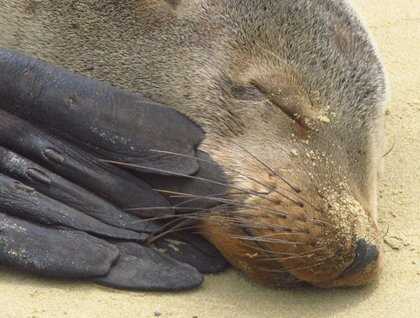East of the Galápagos archipelago lies San Cristobal island. Here we find some of the oldest rocks, some dating back four million years. The northeastern tip of the island is crowned by tall, steep cliffs, remnants of huge tuff cones weathered by the strong winds that blow constantly over this area. This spot is called Punta Pitt, which was the first piece of land spotted by the crew of the HMS Beagle upon arriving in the Galápagos in 1835. It was already late afternoon so Captain Fitzroy decided not to set foot here that day and sailed further south. We, on the other hand, had arrived early in the morning and a visit to Punta Pitt was definitely on our schedule.
We were mainly here to see the third booby species endemic to these islands: the red-footed booby. A large colony inhabits this magic coastline of yellow tuff rock, peridot-rich beaches, and stunning cliffs. The red-footed boobies are pelagic feeders, so they choose the peripheral areas of the archipelago as their home in order to be closer to their foraging areas. Unlike the other two species of boobies, they have prehensile feet so they are able to perch on bushes and trees.
Upon landing we set off for a hike up a dried-up canyon formed by years and years of erosion. It was an exciting climb that gave us breathtaking views of the area. At the far end of the trail, the scenery turned quite colorful thanks to a mantle of red-colored sesuvium (or endemic Galápagos carpetweed) that covered a large patch of tuff. As we leaned over the edge of the platform we realized that there were several red-footed boobies pretty close to us! We were delighted to see them at different stages of their breeding season. We watched some looking after very young, white-fluffy chicks, but also saw several juveniles that were almost ready to fledge. Back at the landing beach, we loved the fact that we shared the beach with a colony of Galápagos sea lions.
Some of them seemed perfectly at ease with our presence and carried on sleeping on the sand, while the youngest sea lions in the water kept approaching the swimmers with intense curiosity!
We left our rocky anchorage by midday, in order to navigate further south. Located off the western coast of San Cristobal is Kicker Rock, an outstanding and impressive geological formation with tall cliffs that offer a safe habitat for various species of marine birds.
In the early part of the afternoon there was a last chance for our fearless snorkelers to explore the deep and mysterious depths around Kicker Rock. Crisscrossed by relatively strong currents due to its distance from the coast, this is a place known for common sightings of various species of sharks, like Galápagos, white- and black-tipped sharks. As if by appointment, they were certainly there today! We also saw Pacific green sea turtles and spotted-eagle rays are usually found here too. A vertical lava rock that seems to have been cut by a gigantic knife reaches from top to bottom and is totally covered by many colorful marine creatures, including sponges, cnidarians, sea anemones, and corals. And, of course, fish were there by the hundreds!
Upon returning on board, the sea was calm and the sun was dipping toward the horizon. The conditions were great for a circumnavigation around this fascinating rock formation. Frigates as well as Nazca and blue-footed boobies fly over this place, or simply rest on its cliffs or top. From the outer decks of the National Geographic Islander, we observed a waved albatross flying in the distance, its home of Espanola Island not too far away. With a drink in hand, we toasted the perfect end of a perfect week in the Enchanted Isles, one of the natural wonders of our world.







